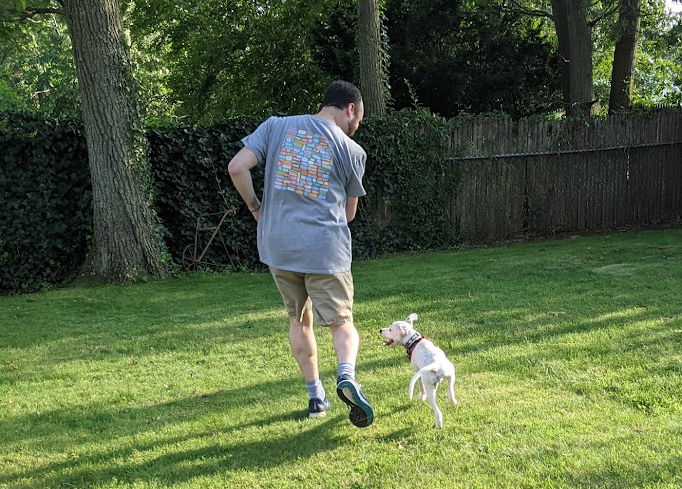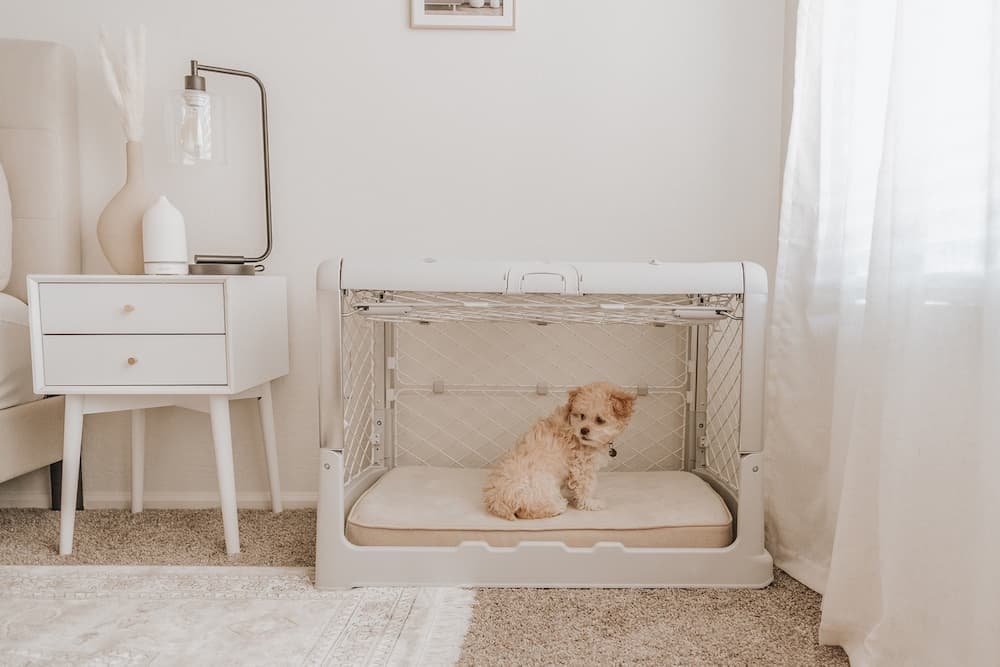Foster Puppies 101: A How-To Guide for Foster Parents

Since the COVID-19 lockdowns in 2020, shelters have reported a tremendous surge in pet fostering and adoptions—and foster puppies became a cuddly, temporary addition to many households. According to a Best Friends Brand Study in 2021, 66 percent of participants fostered a dog or would consider doing so. Companion animals proved to be such a comfort during a difficult time.
During the summer of 2021, my husband and I joined the bandwagon of fostering, welcoming an adorable puppy into our home. I previously raised one of my dogs since puppyhood and thought I was ready to take on raising another. I quickly learned that it involved a lot of work and patience. Thankfully, with help from the rescue and some seasoned foster pet parent friends, I managed to have a wonderful and rewarding experience.
Fostering a puppy is different than taking care of an adult dog. Puppies need a lot more attention, and the role of the foster parent involves helping this tiny animal learn good behavior and become ready for her forever home.
Keep reading to find out everything you need to know about becoming a puppy foster parent. The following tips will also help ensure that you have a memorable and easier experience fostering a puppy.
What Does it Mean to Foster Puppies?

Fostering a puppy means being a temporary guardian who is responsible for the companion animal’s well-being until he or she finds a forever home. While adoption means being the puppy’s permanent caretaker, fostering allows people to take care of a pet temporarily, while waiting for that pet to find a forever home. More importantly, fostering saves lives and frees up space for other pets to be rescued.
“Every dog that we can pull out of a high-kill shelter, or off of the streets and put into a safe foster home, is a life saved. Every puppy that lands in a safe foster home is a life saved,” says Stefanie Pont, adoption director of PMAR (Pibbles and More Animal Rescue) in New York, the rescue I worked with to obtain my foster puppy.
One of the positives of fostering a puppy is that it’s not a long commitment. “Puppies usually get adopted within a month or so. So you get to cuddle an adorable dog and then send them happily off to their forever home,” says Pont. When I brought home a Pit-mix puppy, whom we called Jazzy (short for Jasmine), we thoroughly enjoyed our time playing with her, teaching her tricks, and eventually sending her home with her new family, despite the hard work that was involved.
Of course, one of the questions potential puppy foster parents ask is: “How am I going to be able to part with the animal?” To answer that, Cheyenne Rowell of R Ranch animal rescue in Arizona, who has fostered 19 dogs, says, “You have to understand that you are giving that puppy what she needs now to help get her to her next chapter with her forever family. Every foster is a stepping stone to the next level and offers safety and much-needed love to a pup in need.”
She adds, “I take reassurance in knowing that my foster pups got what they needed from me at the time and have moved on to be part of beautiful families!”
Read more: Learn How to Foster a Pet.
How to Become a Foster Dog Parent

The first step in becoming a foster dog parent is finding the right shelter or rescue. After conducting research on local rescues, I found PMAR, a foster-based rescue that takes in dogs of all ages from cases of abuse, neglect, and abandonment. I decided to work with PMAR after communicating with a long-term volunteer who reassured me of the support the rescue would provide, which I knew I needed if I wanted to be successful. During my time with Jazzy, the rescue gave me support via a Facebook group, as well as a group chat with other fosters who were always available to answer any questions.
The next step was the application process in which I had to share about my living situation, lifestyle, and experience with dogs. As for experience, Pont says it is “nice, but not necessary; we support you through the entire process. And we work with you to find the best fit for your home and skills.”
According to Pont, the key thing to keep in mind when applying to become a foster dog parent is to be able to give the foster a safe space of her own in your home. If there are other animals in the house, it’s better if they are tolerant of the temporary new addition.
Pont states that fostering may not be a good idea for those who travel frequently or live in a rental property that does not favor dogs. An older pup or an adult dog may be a better option for people who are away from home all day. It is generally not recommended to leave puppies alone for more than four consecutive hours. However, if you work outside the home and want to foster a puppy, Pont recommends using a “dog walker or family member to bridge the gap while away.”
And if you don’t have a yard, don’t worry. Pont says they have many fosters and adopters without yards because puppies are not supposed to interact with other dogs until they have all of their shots. She suggests using puppy pads in the beginning if the pups are very young and then to safely walk them outside several times a day using a harness as they grow older so they can acclimate to the outside world.
How to Foster Puppies: 7 Important Tips
Being a temporary guardian of a puppy involves a significant time commitment and patience as they need to be taken outside more regularly and fed/played with often. It can also be one of the most rewarding experiences of our life. This small animal is reliant on the stand-in parent for love, sustenance, and guidance and will return the favor with unconditional love and cuddling.
With an adult foster dog, Pont says that the foster’s job is to “assess their personality and behavior and to make sure that the best home for that dog can be found.” However, for foster puppies, she states that “foster parents get to help to form their personality and teach them what is and isn’t acceptable, how to react to situations and people around them.” Often, the rescue gets puppies without a mother available (deceased, missing, etc.) and the foster parent takes their place, teaching the puppies good behavior to help them become more adoptable.
Below are some helpful tips for how to foster puppies, including information on the preparation and training needed, costs and time commitment, veterinary visits, and additional details.
Puppy Proofing

Before bringing your foster dog home, puppy proof your house so she doesn’t get into trouble. A general rule of thumb, according to Pont, is “if it’s below knee level, pick it up, from shoes and clothes to stuffed animals.” When the puppy is out of her crate, she will be loose in the house, at which point it’s imperative to keep an eye on her to ensure she doesn’t chew your furniture or pee on that priceless rug. Pont also recommends covering or elevating electrical cords, closing doors to basements or rooms that you don’t want the puppy going into, and securing outdoor areas so she doesn’t run out.
Puppy Food and Supplies
Various shelters/rescues operate differently when it comes to what is provided for the foster animal and her temporary parents. Some provide supplies such as food and toys, while others cover only medical expenses. In my situation, I provided Jazzy with food, toys, and bowls, while the rescue provided a leash, collar, and deworming and flea/tick medication. The rescue also covered a visit to the clinic to get her vaccinations and fecal test. Be prepared to spend anywhere from $100 to $300 on food, toys, and a crate. These will prove necessary to create the best environment for your foster puppy.
Crate Training

Crates seem confining and most people have a misconception of them being a form of punishment. However, dogs like to have a safe, “den-like” space to retreat to for some rest and alone time, away from the activities elsewhere in the house. Our foster puppy Jazzy loved getting into her crate whenever she was tired or needed a break. Sometimes, she’d entertain herself with toys and tire herself out before falling asleep in the crate. We helped her become accustomed to the crate by associating it with positive things, including feeding her inside the crate and giving her lots of praise when she was calmly inside.
“Everybody should have a warm, cozy place to feel safe,” says Pont, adding that it’s like putting a baby in the crib for a nap. Crating, according to Pont, is also a great way to secure the animal when you are not around, particularly in the beginning when she is unsure about her new surroundings.
In cases where you are caring for multiple foster puppies, confining them to a small area like a hallway with baby gates helps, suggests Rowell, who once cared for seven pups simultaneously. Rowell used Visqueen, a plastic landscape and construction barrier, to line the floor and walls about one foot deep. Then, she created little “stations”: a potty station with potty pads on one end, away from toys, beds, and water; a water station with a shallow, tip-proof water dish; and a bed station with a comfy puppy bed, and an open area for them to play.
Giving the Puppy Time to Adjust and Meet Other Pets

When I brought Jazzy home, PMAR recommended a two-week shutdown period, where we placed the puppy in a designated area (in our case, a bathroom) with her crate, water bowls, and toys, to give her space to become accustomed to her new surroundings and to our other dogs. This also prevents the puppy from getting overwhelmed by the entire place.
If you have other pets, Pont recommends keeping the dogs separate from the puppy, letting them see and smell each other during the first two weeks. “This will allow the resident dog(s) to get used to the new member, and the pup to figure out what is going on.” When we needed to take Jazzy outside, we made sure she didn’t meet our other dogs during those first two weeks. This time away from other pets also ensures that the resident dogs won’t catch any worms or fleas the puppy may be hosting (until the dewormers do their magic).
After the two-week shutdown, the puppy can slowly be introduced to the other pets with supervision. “Never leave your puppy alone with any other animal until they are well acclimated and you are very sure they are accepted,” warns Pont.
Potty Training and Establishing a Routine
Most articles on puppy potty training recommend starting at 12 weeks, but there is no set time to begin. In fact, it’s easier to start the training sooner than later, which I learned the hard way. The first few days of Jazzy being home, I struggled cleaning up after her potty accidents. Then, a volunteer in a PMAR group chat suggested I start potty training by taking her out into the yard more regularly. So, my husband and I made a schedule and took turns taking her outside every couple of hours. And just like that, our lives got easier and Jazzy soon adapted to her new schedule.
When I consulted with Rowell for some advice, she suggested I implement a routine to make caring for Jazzy easier. Her mantra for the puppy includes: Eat, play, poop, sleep and repeat. “The puppies quickly learn what is happening next, when it is nighttime, time to eat, time to play, etc.,” she says. More logistically, she adds, “puppies poop about 30 minutes after eating, so if you feed them at a certain time, you know there will be a poop time and can make sure you are helping them become potty trained more efficiently.”
Puppy Training and Socialization

Most shelters and rescues expect puppy foster parents to help housebreak the dog, teach basic manners if the pup is old enough (sit, stay, come), and eliminate any bad habits, such as nipping, chewing on things that are off limits, and jumping.
As for socialization, Pont says it is a little difficult with young puppies, as they should not be playing with other pets until they have their shots and rabies vaccine. However, socialization can take place within the litter or with the dogs in your home once they are cleared of any worms. Taking the puppy for shots and administering worming meds (just a pill) is easy to accomplish.
Veterinary Visits and Adoption Events
Foster parents are often asked to bring the dog to the clinic so she can get her vaccinations and rabies shots, as well as check for any worms. During pre-COVID times, fosters were also asked to bring the pups to adoption events at local pet stores and other locations. Nowadays, virtual marketing is used to get the dog adopted and, as such, foster pet parents are often asked to provide good photos of the puppy to showcase her personality and good behavior. If you want to go the extra mile, fosters may also post about their foster puppy on social media to garner interest and get her adopted. For veterinary visits, it’s best to put the dog in a harness in the backseat or place her in a crate for her safety.
Foster Puppies: A Rewarding Experience

Fostering a puppy was such a rewarding experience for my husband and me. We are so grateful to have provided Jazzy with three weeks of love, care, and training. During such a short period of time, she stole our hearts and forever embedded herself in our memories. I will remember her silly antics trying to climb the crate or chasing butterflies in the yard, her soft warm belly after a long nap, and the sweet puppy smell when I first held her in my arms.
Jazzy is now a beloved member of a family of three and goes by the name Rosie. She will grow up alongside a young girl and is no doubt going to make their lives extremely special. Fostering allowed us to not only give Jazzy/Rosie a chance at a wonderful life, but also provide a beautiful family with a loving dog.
Of course, some foster parents “fail” and end up adopting their foster pets. Rowell did that with her 19th foster pup, but she’s eager to get back to fostering. That’s the beauty about fostering—once you do it, you want to feel that joy and rush of seeing an animal blossom in front of your eyes and find her happy ending all over again.









